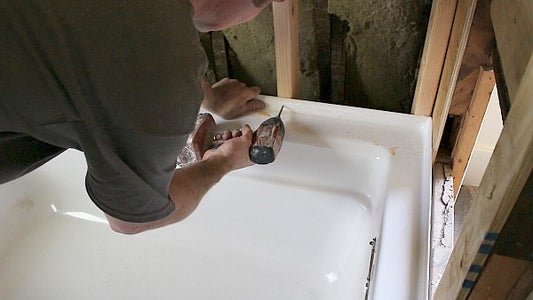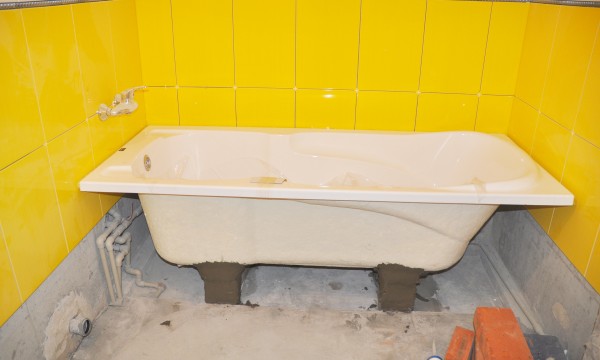Exactly How to Install a Tub Yourself: Removing and Replacing.
Exactly How to Install a Tub Yourself: Removing and Replacing.
Blog Article
We have noticed this great article about How to Install a Bathtub Yourself listed below on the web and decided it made good sense to share it with you here.

Setting up a tub isn't exactly rocket science, yet it does call for strong plumbing, carpentry, and sometimes, tiling abilities. Changing an old tub with a new one is additionally a reasonably tough job. If the old tub is conveniently easily accessible, the project can move easily; if you need to open a wall to get rid of the old bathtub and place the brand-new tub, the task is a lot harder. In either situation, the project is within a residence handyman's abilities, although you will require an assistant to move out the old bathtub as well as set in the brand-new one. Make certain you have actually certified yourself for the job and also fit attempting it. Rather than hiring a service provider to take control of a halfway-completed job, it is better to consider utilizing one before you start. Possibilities are you may require a specialist plumber to make tube connections.
This article will certainly assist you install a brand-new tub in your restroom if you have actually currently purchased a brand-new bathtub and do not require to change the setup of your previous water system pipes.
Your devices as well as product list must make up the following:
Removing Old Touches
If you need to replace old faucets with new ones as a part of your installation, after that the first thing you must do is disconnect the water. After doing so, activate the taps to drain pipes any type of water remaining in the system. The procedure of eliminating the existing taps can be fairly troublesome due to the limited gain access to that is often the instance.
Utilize a container wrench (crowsfoot spanner) or a tap tool to reverse the nut that attaches the supply pipelines to the faucets. Have a fabric ready for the staying water that will certainly come from the pipelines. When the supply pipelines have been removed, utilize the same device to loosen the nut that holds the faucets onto the bath/basin. You will need to quit the single faucets from turning throughout this process. As soon as the faucets have been gotten rid of, the holes in the bath/basin will need to be cleaned of any type of old securing compound.
Before going on to fit the new faucets, compare the pipe links on the old taps to the brand-new taps. If the old faucets are longer than the brand-new taps, after that a shank adapter is required for the new faucets to fit.
Fitting New Touches
If the tails of the brand-new taps are plastic, after that you will need a plastic adapter to prevent damages to the string. One end of the port fits on the plastic tail of the faucet and the other end gives a connection to the existing supply pipelines.
If you need to fit a monobloc, then you will certainly require decreasing couplers, which attaches the 10mm pipe of the monobloc to the conventional 15mm supply pipeline.
Next, position the faucet in the placing hole in the bath/basin making sure that the washing machines are in location in between the tap and the sink. Protect the faucet in place with the producer supplied backnut. As soon as the faucet is securely in place, the supply pipelines can be attached to the tails of the faucets. The taps can either be linked by utilizing corrugated copper piping or with regular faucet connectors. The former type must be attached to the tap ends first, tightening just by hand. The supply pipelines can later on be connected to the other end. Tighten both ends with a spanner after both ends have actually been attached.
Mounting the Bathtub
Using the two wooden boards under its feet, put the tub in the called for placement. The wood boards are helpful in evenly spreading the weight of the tub over the area of the boards rather than concentrating all the weight onto 4 tiny factors.
The following objective is to make certain that the bathtub is leveled all round. This can be achieved by checking the level and also readjusting the feet on the bath tub till the level reviews degree.
To mount faucets, fit all-time low of the outermost adaptable faucet adapter to the proper supply pipeline by making a compression sign up with; after that do the exact same for the various other tap.
Turn on the supply of water as well as inspect all joints and new pipework for leaks and tighten them if essential. Load the bath tub as well as likewise inspect the overflow outlet as well as the normal outlet for leakages.
Ultimately, take care of the bathroom paneling as explained in the producer's instruction manual. Tiling and securing around the bath tub must wait up until the bathtub has been made use of at the very least when as this will settle it right into its last setting.
Getting ready for the Installation
Firstly, the sustaining framework supplied with the bath needs to be fitted (if called for) according to the producer's instructions. Next off, fit the faucets or mixer to the tub. When fitting the faucet block, it is very important to ensure that if the tap features a plastic washing machine, it is fitted between the bathroom as well as the taps. On a plastic bathroom, it is additionally practical to fit a supporting plate under the faucets system to prevent pressure on the tub.
Fit the flexible faucet connectors to the bottom of both taps using 2 nuts as well as olives (in some cases provided with the bathtub). Fit the plug-hole outlet by smearing mastic filler round the sink electrical outlet hole, and afterwards pass the electrical outlet through the hole in the bathroom. Utilize the nut provided by the maker to fit the plug-hole. Examine the plug-hole electrical outlet for an inlet on the side for the overflow pipe.
Next off, fit completion of the versatile overflow pipe to the overflow electrical outlet. After that, screw the pipeline to the overflow face which ought to be fitted inside the bathroom. Ensure you make use of all of the provided washers.
Attach the trap to the bottom of the waste electrical outlet on the tub by winding the string of the waste outlet with silicone mastic or PTFE tape, and also screw on the trap to the electrical outlet. Connect all-time low of the overflow tube in a similar manner.The bathroom should now prepare to be fitted in its last position.
Tiling Around the Tub
In the area where the bath fulfills the ceramic tile, it is essential to seal the accompanies a silicone rubber caulking. This is important as the fitting can relocate enough to split a rigid seal, causing the water to permeate the wall surface between the bathroom and the tiling, resulting in difficulties with dampness as well as feasible leakages to the ceiling listed below.
You can choose from a range of coloured sealers to assimilate your components and fittings. They are offered in tubes as well as cartridges, and also can sealing gaps as much as a width of 3mm (1/8 inch). If you have a bigger void to load, you can fill it with twists of soaked newspaper or soft rope. Keep in mind to constantly load the bath tub with water prior to securing, to allow for the movement experienced when the tub is in use. The sealant can split relatively very early if you do not think about this movement before sealing.
Alternatively, ceramic coving or quadrant tiles can be used to edge the bath or shower tray. Plastic strips of coving, which are easy to use as well as cut to size, are likewise quickly offered on the market. It is a good idea to fit the ceramic tiles utilizing waterproof or water resistant sticky as well as grout.
Bathtub Installation
How Important Is A Bathtub To Your Home?
High-quality baths, showers, and other bathroom updates are necessary when considering a smart investment in your home. It’s a room that you go to every day and one that is constantly being used by guests.The bathroom is one of the top trafficked rooms in a home and also one of the most valuable in terms of home resale.
Install Piping Before Tub
You will be using your existing drain and waste vent system, but pipes required include the hot and cold water supply lines and a pipe leading to a shower head. A mixing valve and shower head are also needed. Air chambers may be required.
Position the Tub
Lower the tub into place so that the continuous flange fits against the wall studs and rests on 1’x4' or 2’x4' supports. Anchor the tub to the enclosure with nails or screws inserted through the flanges into the studs.
NOTE: Remember, bathtubs and shower stalls may require support framing. A bathtub filled with water is extremely heavy, so check building codes and framing support before installing the tub.
Assemble Drain Connections
Assemble the bathtub drain connections by connecting the tub overflow with the tub drain above the trap, not beyond it. The trap will have a compression fitting that screws over the arm of the overflow assembly.
Place a Pipe For the Shower Head
First, locate a brass female threaded winged fitting and attach it to a framing support via a screw or a nail. Then run a pipe up the wall for the shower head. Sweat or solder the other side of the brass fitting to the top of the pipe.
Attaching Hot and Cold Water Lines
Attach your water lines for both hot and cold by sweating these directly into the hot and cold ports of the mixing valve. The mixing valve will be how water enters the tub’s system, not by the pipes themselves.
Install the Spout
Extend a piece of 1/2 inch pipe, or whichever length is specified in the manufacturer’s instructions, for the tub spout. Sweat on a male threaded fitting at the end of the pipe or use a brass nipple of the proper length and a 1/2 inch cap.
NOTE: At this point you should have your rough-in plumbing work inspected before proceeding further.
Check For Leaks
Restore the water pressure and check the drain connection and the supply pipes for any sign of leaking.
estore the Bathroom Wall
Replace the wall with moisture-resistant drywall as a base for your wall covering. Seal the joints between the wall and your new tub with silicone caulk as protection against water seepage.
https://www.berkeys.com/2016/12/02/bathtub-installation-dallas/

Do you like more info about A Step-by-Step Guide to Installing a Bathtub? Leave a remark directly below. We will be pleased to listen to your feelings about this write-up. Hoping that you visit us again in the near future. Those who appreciated our post kindly make sure you remember to pass it around. I love reading our article about How to Install a Bathtub Yourself.
Book Appointment Report this page